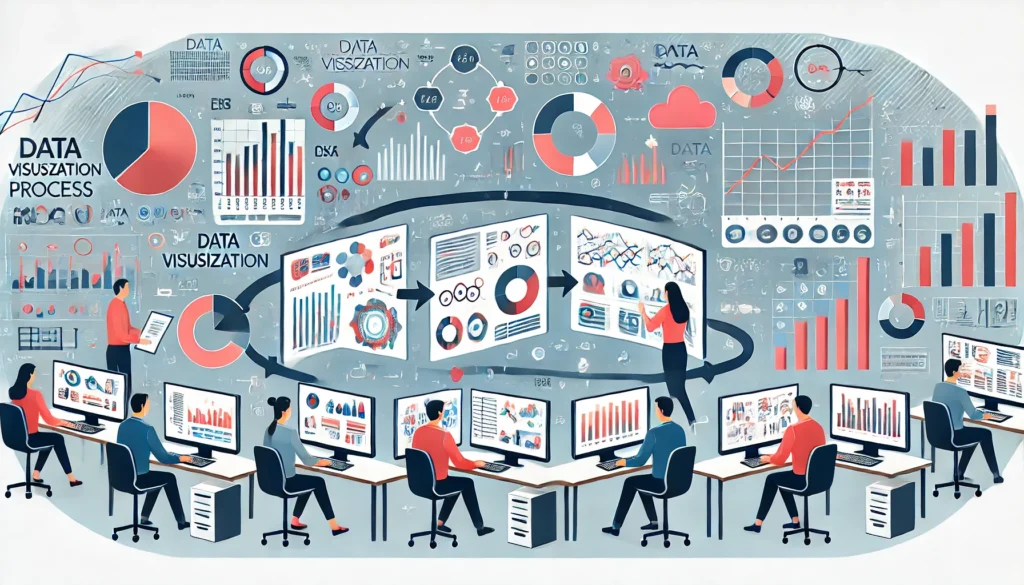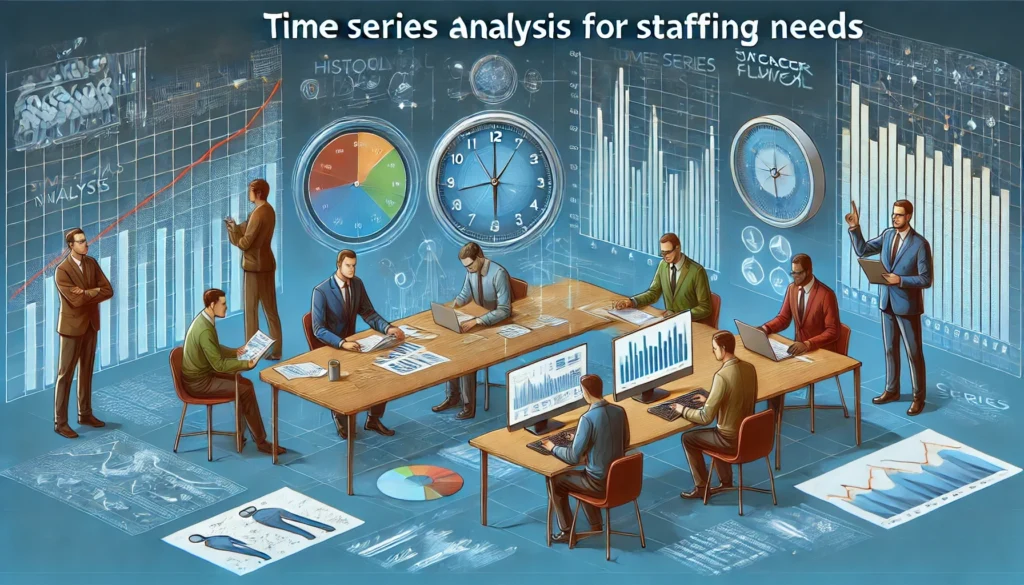Data analytics in human resources for enhanced decision-making

Previous article: Building successful relationships with foreign customers
Struggling with project delays and staffing headaches? You're not alone. In today's dynamic business world, smart decisions are vital. Enter data analytics in human resources: your tool for predicting needs and ensuring smooth project management.
This article reveals how data analytics can streamline your operations and optimize your team’s fit for every task. Say goodbye to guesswork and embrace data-driven success!
Staff augmentation for outsourcing companies 101
- Scaling workforce without losing quality
- Communication in teams and cross-cultural team management
- Building successful relationships with foreign customers
- Using data analytics in human resources for better decisions — you are here
- Data leakage prevention in hybrid teams
Fundamentals of data analytics in outsourcing
Data analytics in human resources involves examining, cleaning, transforming, and modeling data to support decision-making. In outsourcing, it enhances efficiency by:
Collecting and integrating data from multiple sources
Imagine a global company outsourcing customer support. Data analytics in HR can gather information from customer interactions across various channels—emails, chats, calls—and integrate it into a unified system. This comprehensive view helps identify common issues and improve response strategies.
Preparing data for analysis
Think about a healthcare provider outsourcing medical billing. Data analytics can clean and standardize patient records from different databases, ensuring consistency. This preparation step is crucial for accurate billing and minimizes errors that could lead to claim rejections.
Uncovering patterns with statistical techniques
Consider an e-commerce business outsourcing inventory management. By applying statistical techniques, data analytics can reveal purchasing patterns and seasonal trends. This insight helps in anticipating demand and optimizing stock levels, reducing overstock and stockouts.

Visualizing findings effectively
Visualizations transform complex data into understandable formats. For example, a marketing firm outsourcing campaign analytics might use dashboards to display key performance indicators. This clarity allows managers to quickly grasp the success of different strategies and adjust tactics accordingly.
Using insights for process optimization and strategic decisions
A logistics company outsourcing route planning can leverage data analytics to identify the most efficient delivery routes. This optimization reduces fuel costs and delivery times, enhancing overall service quality and customer satisfaction.
Relevance to outsourcing operations
Data analytics in human resources is crucial for outsourcing due to several key benefits:
Performance optimization
Data analytics optimizes performance by identifying inefficiencies, such as redundant processes, and suggesting improvements. For instance, a company reduced operational costs by 10—15% by reallocating resources based on data insights. This means smoother operations and better use of company assets.
Cost management
Better resource allocation through data-driven insights leads to significant cost savings. Imagine a manufacturing firm outsourcing supply chain management. By analyzing supplier performance data, the firm can negotiate better terms or switch to more reliable suppliers, thus saving money and reducing delays.
Quality assurance
Monitoring and enhancing service quality becomes easier with data analytics in human resources. For example, a customer service center outsourcing its call operations can use analytics to track call resolution times and customer satisfaction scores. This data helps in training staff and improving service protocols, ensuring high-quality service delivery.
Risk mitigation
Predicting and addressing potential risks is another crucial benefit. A financial institution outsourcing its fraud detection can use data analytics to identify unusual transaction patterns. This proactive approach helps in mitigating fraud risks, protecting both the institution and its customers.

Strategic decision-making
Data analytics in human resources and project management informs long-term strategies with valuable insights, particularly as companies navigate the complexities of modern business environments. For instance, consider a tech company outsourcing its R&D functions. By leveraging predictive analytics, the company can scrutinize market trends and consumer feedback, enabling strategic decisions that keep them competitive.
In fact, a report by Gartner highlighted that 49% of HR leaders prioritized the future of work in 2023, with 46% increasing investments in related initiatives. This surge in focus underscores the critical role of analytics in guiding decisions like outsourcing and product development, ensuring companies stay ahead of the curve.
Types of data analytics and their applications in outsourcing
Descriptive analytics
Descriptive analytics focuses on understanding past events. It summarizes historical data to provide insights into patterns and trends.
Applications in outsourcing:
Analyzing historical performance data of outsourcing partners
- Example: A global retailer uses descriptive analytics to evaluate the past performance of its IT outsourcing vendors. By analyzing metrics such as response times, issue resolution rates, and customer feedback, the retailer can identify which vendors have consistently met or exceeded expectations, helping them make informed decisions for future contracts.
Tracking key performance indicators (KPIs) over time
- Example: A manufacturing company tracks KPIs like production downtime, defect rates, and delivery times across its outsourced production facilities. This data helps the company spot trends, such as a gradual improvement in defect rates following the implementation of a new quality control process.
Identifying trends in customer satisfaction or service quality
- Example: A customer service outsourcing firm uses descriptive analytics to monitor customer satisfaction scores and call resolution times. By analyzing this data over the past year, they identify a trend where satisfaction scores drop during peak call times, leading to adjustments in staffing to better handle these periods.
Predictive analytics
Predictive analytics uses historical data and statistical algorithms to forecast future outcomes.
Applications in outsourcing:
Forecasting resource needs based on historical demand patterns
- Example: An e-commerce company uses predictive analytics to forecast customer support needs during the holiday season. By analyzing historical call volume and customer inquiry data, they predict a 50% increase in support tickets and adjust their staffing levels accordingly to handle the surge.
Predicting potential service disruptions or quality issues
- Example: A logistics company uses predictive analytics to predict potential delays in shipments based on historical weather data, traffic patterns, and previous delivery times. This allows them to proactively reroute shipments to avoid expected disruptions.
Anticipating changes in customer behavior or preferences
- Example: A software development firm anticipates shifts in client demand for specific features by analyzing historical usage patterns and market trends. This approach allows them to prioritize development efforts on features poised for increased use, ensuring their product roadmap aligns seamlessly with customer needs.
Supporting this strategy, the global custom software development market is projected to grow at a compound annual growth rate (CAGR) of 22.3% from 2022 to 2030. This significant growth highlights the rising demand for tailored software solutions, underscoring the importance of aligning development efforts with evolving customer requirements and market dynamics.
Prescriptive analytics
Definition: Prescriptive analytics goes beyond predicting future outcomes to recommending actions that should be taken to achieve desired results.
Applications in outsourcing:
Optimizing resource allocation across different outsourcing partners
- Example: A telecom company uses prescriptive analytics to allocate network maintenance tasks across multiple outsourcing partners. By analyzing each partner's performance data and capacity, the system recommends the optimal allocation of tasks to ensure timely and cost-effective maintenance.
Recommending process improvements to enhance efficiency
- Example: A financial services firm employs prescriptive analytics to streamline its loan processing operations. The analytics suggest specific changes, such as automating certain document verification steps, which leads to a 20% reduction in processing time and a significant decrease in errors.
Suggesting proactive measures to mitigate potential risks
- Example: A healthcare provider uses prescriptive analytics to identify high-risk patients for chronic disease management programs. The system recommends proactive interventions, such as regular follow-ups and personalized care plans, reducing hospital readmission rates by 15%.
Enhancing project management with data analytics in human resources
Project performance data analytics
Monitoring key performance indicators (KPIs)
KPIs are specific metrics used to evaluate the success of a project. Common KPIs include cost variance, schedule variance, and quality metrics.
- Application: By continuously tracking these KPIs, project managers can assess project health and identify areas needing improvement. Real-time tracking tools and dashboards significantly enhance this process, offering clear visualizations of key metrics that simplify communication with stakeholders.
According to the State of Project Management Report, nearly 50% of organizations do not have access to real-time project KPIs, and 47% of respondents spend one or more days per month manually collating project reports. This indicates a substantial opportunity for improvement through the adoption of automated reporting tools that provide up-to-date data anytime, anywhere. - Example: A construction company uses a dashboard to monitor KPIs such as project completion percentage, budget adherence, and safety incidents. This real-time visibility allows them to quickly address any deviations from the plan and keep stakeholders informed.
Data visualization
Data visualization involves presenting data in graphical formats such as charts, graphs, and dashboards.
- Application: Visualization tools help project managers quickly grasp key performance metrics and trends, facilitating better reporting and communication. This aids in understanding project performance and aligning tasks towards achieving business value.
- Example: A marketing agency uses data visualization tools to display campaign performance metrics such as click-through rates, conversion rates, and ROI. This visual representation helps the team make data-driven decisions and optimize future campaigns.

Performance reports
Performance reports compile data on project progress, resource utilization, and financial health.
- Application: These reports provide a detailed overview of the project’s status, helping project managers make informed decisions about adjustments needed to stay on track.
- Example: An IT project manager generates weekly performance reports summarizing progress on milestones, resource usage, and budget status. These reports highlight areas that require attention and guide decision-making to ensure the project stays on course.
Predictive data analytics in human resources for project outcomes
Forecasting
Predictive analytics uses historical data and statistical algorithms to forecast future project performance.
- Application: By analyzing past project data, predictive analytics can anticipate potential bottlenecks, resource constraints, and project delays. This allows project managers to proactively address issues before they escalate, ensuring project tasks are completed within allocated timelines and resources.
- Example: A software development team leverages predictive analytics to forecast potential delays in feature delivery. By identifying patterns of delay from past projects, they can proactively implement measures to mitigate these risks, such as adding additional resources or adjusting timelines.
According to a Wellingtone's report "The State of Project Management", 70% of project managers using predictive analytics successfully identified potential risks and delays earlier in the project lifecycle. This proactive strategy allows teams to effectively manage risks and stay on track. Additionally, the use of AI-powered predictive analytics has improved the accuracy of project timeline estimates by 30%, enabling teams to forecast delivery times more precisely and allocate resources more efficiently.
Risk mitigation
Predictive data analytics in human resources identifies potential risks and issues that could impact project outcomes.
- Application: By forecasting potential risks, project managers can take corrective actions early, such as reallocating resources or adjusting timelines, to mitigate these risks and avoid project disruptions.
- Example: A pharmaceutical company uses predictive analytics to identify potential risks in its drug development pipeline, such as delays in clinical trials. By proactively addressing these risks, they can keep the project on track and avoid costly setbacks.
Scenario analysis
Scenario analysis involves evaluating different potential future scenarios based on current data.
- Application: This helps project managers understand the impact of various decisions and choose the best course of action to achieve desired project outcomes.
- Example: An automotive manufacturer uses scenario analysis to evaluate different production schedules. By comparing scenarios, they can identify the optimal schedule that minimizes downtime and maximizes output.
Optimizing resource allocation
Resource management tools
These tools track the allocation, availability, and utilization of resources throughout the project lifecycle.
- Application: By analyzing resource data, project managers can optimize resource allocation, ensuring that resources are used efficiently and effectively. This helps avoid bottlenecks and ensures that the right resources are available when needed.
- Example: A consulting firm uses a resource management tool to allocate consultants to various projects based on their skills and availability. This ensures that each project has the necessary expertise without overloading any individual consultant.
Demand forecasting
Predictive analytics can forecast future resource needs based on historical demand patterns.
- Application: This enables project managers to plan resource allocation more accurately, ensuring that projects have the necessary resources to meet their goals without over-allocating or under-utilizing resources.
- Example: A retail chain uses demand forecasting to predict staffing needs for its stores. By analyzing sales data and seasonal trends, they can ensure optimal staffing levels during peak shopping periods.
Real-time adjustments
Real-time data analytics allows for continuous monitoring and adjustment of resource allocation.
- Application: By tracking resource utilization in real time, project managers can make immediate adjustments to address any inefficiencies or imbalances, ensuring optimal resource use throughout the project lifecycle.
- Example: A logistics company uses real-time data analytics to monitor the utilization of its delivery fleet. By tracking vehicle locations and delivery statuses, they can make on-the-fly adjustments to routes and schedules, improving efficiency and reducing delivery times.
Predicting staffing needs with data analytics in human resources
This is a powerful approach that enables organizations to optimize their workforce planning and management. By leveraging data-driven techniques, companies can ensure they have the right people with the right skills at the right time.
Trend analysis and forecasting
Historical data analytics in human resources
- Examine past hiring patterns: Review past hiring trends, turnover rates, and workforce changes over time.
- Identify seasonal fluctuations: Understand cyclical trends in staffing needs related to seasons or specific business cycles.
Demand forecasting
- Analyze influencing factors: Study factors such as seasonality, customer behavior, and market trends to understand their impact on staffing needs.
- Use predictive models: Employ predictive models to estimate future staffing requirements based on projected demand for products or services.
Time series analysis
- Apply statistical techniques: Utilize statistical methods on historical data for forecasting future staffing needs, accounting for business growth, industry changes, and economic conditions.

Skill gap analysis
Current skill assessment
- Evaluate existing skills: Assess the current skills and competencies within the organization through performance reviews, skills assessments, and employee profiles.
Future skill requirements
- Analyze industry trends: Predict future skill needs by examining industry trends and technological advancements.
- Align with strategic goals: Consider the organization’s strategic objectives and upcoming initiatives to determine future skill requirements.
Gap identification
- Compare current and future skills: Identify skill gaps by comparing current workforce capabilities with projected future needs.
- Prioritize skill gaps: Focus on skill gaps that significantly impact organizational goals and objectives.
Dynamic staffing models
Real-time data utilization
- Incorporate real-time data: Use real-time data on workload, productivity, and market conditions to inform staffing decisions.
- Continuous monitoring: Employ analytics tools to continuously monitor and adjust staffing levels as needed.
Scenario planning
- Develop multiple scenarios: Create various staffing scenarios based on potential future outcomes.
- Evaluate likelihood and impact: Use predictive analytics to assess the likelihood and impact of each scenario.
Flexible workforce strategies
- Mix workforce types: Implement a blend of full-time, part-time, and contingent workers to maintain flexibility.
- Optimize workforce balance: Use analytics to determine the optimal mix of different worker types for agility and efficiency.
Implementation strategies
To effectively predict staffing needs using these analytics approaches:
- Invest in robust data systems: Ensure high-quality, reliable data through advanced data collection and management systems.
- Utilize advanced analytics tools: Leverage AI-powered solutions and advanced analytics tools for deeper insights and predictive capabilities.
- Integrate with HR technologies: Combine predictive analytics with other HR technologies, such as applicant tracking systems and employee management software.
- Refine predictive models continuously: Update predictive models regularly based on new data and evolving business conditions.
- Combine quantitative and qualitative insights: Integrate quantitative analysis with qualitative insights from HR professionals and business leaders for a comprehensive approach.
Scenario: Predicting staffing needs for a healthcare telehealth software development project
1. Historical data analysis
Over the past two years, Valletta Software Development has completed several telehealth software projects. Analysis of these projects reveals that during the final development phase, an increased need for front-end developers and quality assurance testers arose due to the high volume of UI/UX refinements and compliance testing required. For instance, in a similar project completed last year, an additional three front-end developers and two QA testers were required for the final three months.
2. Demand forecasting
Predictive models highlight several factors influencing future staffing needs:
- Regulatory changes. Anticipated updates in healthcare regulations promoting telehealth services suggest a 30% increase in demand.
- Seasonal trends. Historical data shows a surge in telehealth usage during winter months due to higher rates of seasonal illnesses.
- Market trends. Increasing patient preference for remote consultations drives a projected 25% rise in telehealth service demand.
Combining these factors, the models predict a significant spike in demand for telehealth solutions over the next six months.

3. Skill gap analysis
Current skill assessment
Valletta's current team includes developers proficient in healthcare software standards, but there is a limited number of experts with experience in advanced telehealth technologies and AI integration for diagnostic tools.
Future skill requirements
To meet the projected demand, Valletta will need:
- Advanced telehealth integration skills. Proficiency in developing and integrating AI-driven diagnostic tools within telehealth platforms.
- Compliance expertise. In-depth knowledge of updated healthcare regulations and data privacy laws.
- Scalable infrastructure management. Skills in managing and scaling telehealth infrastructure to handle increased user loads.
Gap identification
Comparing current capabilities with future needs, Valletta identifies gaps in AI integration and compliance expertise. These gaps are prioritized for immediate addressing to align with the company’s strategic goal of leading in telehealth solutions.
4. Dynamic staffing models
Real-time data utilization
Valletta uses real-time analytics to monitor current project workloads and team productivity. For instance, data shows that the current project for a major healthcare provider is 80% complete. This allows for reallocation of three developers from this project to the telehealth initiative to address immediate needs.
Scenario planning
Several staffing scenarios are developed:
- Scenario 1. Demand increases by 20% — requiring two additional AI specialists and one compliance officer.
- Scenario 2. Demand surges by 30% — requiring four additional AI specialists, two compliance officers, and three front-end developers.
- Scenario 3. Demand remains stable — no additional hires needed, but a reallocation of existing resources.
Predictive analytics evaluate these scenarios, showing the highest likelihood for Scenario 2.
Flexible workforce strategies
Valletta employs a flexible staffing model, combining full-time, part-time, and contingent workers:
- Full-time. Hire four full-time AI specialists.
- Part-time. Engage two part-time compliance officers.
- Contingent. Use contingent front-end developers during peak phases to handle increased workload.
5. Implementation strategy
To implement the staffing plan:
- Robust data systems. Valletta uses advanced systems like Snowflake and Redshift for data collection and management to ensure high data quality.
- Advanced analytics tools. AI-powered tools like Databricks and DataRobot provide deeper insights and predictive capabilities.
- Integration with HR technologies. Valletta seamlessly integrates predictive analytics with top-tier applicant tracking systems like Greenhouse and Lever, streamlining recruitment processes.
- Continuous model refinement. Predictive models are regularly updated with new data for improved accuracy using tools like H2O.ai and MLflow.
- Quantitative and qualitative insights. Valletta combines the power of data analytics with valuable feedback from HR professionals, ensuring a comprehensive and well-rounded staffing strategy.
Choosing and implementing analytics tools into your infrastructure
Checklist for choosing analytics tools
Here's a checklist for choosing the right analytics tool, formatted as statements:
Aligns with analytics objectives and KPIs.
Supports required data types and sources.
Handles current and projected data volumes.
Integrates with existing systems.
Offers an intuitive interface and customizable dashboards.
Provides real-time processing and advanced features.
Meets security standards and budget constraints.
Integrating new analytics tools with your existing IT infrastructure
Integrating new analytics tools with your existing IT infrastructure doesn't have to be a daunting task. By following a strategic approach, you can ensure seamless integration and maximize the utility of your data.
1. Define your goals
Before you start integrating, clearly outline your objectives. Are you aiming to improve decision-making, optimize processes, or track specific KPIs? By defining your goals, you can choose the right tools and integration strategies that align with your broader business objectives.
2. Assess your systems
Take a comprehensive look at your existing IT systems. Identify your current data sources, formats, and storage locations. Assess the capabilities and limitations of your infrastructure. This will help you identify potential integration points and any bottlenecks that might hinder data flow.
3. Choose compatible tools
Select analytics tools that are compatible with your current technology stack. Look for solutions that offer robust APIs and pre-built connectors to common systems like CRMs, ERPs, and data warehouses. Cloud-based options often provide greater flexibility and scalability for easier integration.
4. Prioritize data governance
Establish clear policies for data ownership, access, and security. Ensure data quality and consistency across systems, and implement robust data privacy measures to protect sensitive information.
5. Leverage ETL processes
Implement automated ETL (Extract, Transform, Load) pipelines to extract data from various sources, transform it into a usable format, and load it into your analytics platform. This ensures that your data is consistent, clean, and ready for analysis.

6. Centralize your data
Consider implementing a data warehouse or data lake to consolidate data from multiple sources. This centralized repository provides a single source of truth for your analytics tools, simplifying data access and promoting consistency.
7. Real-time integration (if necessary)
If real-time data analysis is crucial for your business, explore options for real-time data integration. This may involve using APIs, streaming technologies, or event-driven architectures to trigger analytics processes as soon as new data becomes available.
8. User access and training
Ensure that users have appropriate access levels to analytics tools based on their roles. Provide comprehensive training on how to use the integrated systems effectively. Create intuitive dashboards and interfaces for easy data exploration.
9. Start small, scale up
Begin with a pilot project to test the integration with a limited scope. This allows you to identify potential issues and refine your approach before scaling up to a full-fledged integration.
10. Continuous monitoring and optimization
Regularly assess the performance and utility of your integrated analytics system. Gather feedback from users and stakeholders and make continuous improvements based on evolving needs.
Ensuring ethical and effective data-driven decision-making
Addressing ethical considerations
When making decisions based on analytics, several important ethical concerns related to data privacy, security, and integrity must be addressed:
Data privacy
- Consent and transparency. Ensure proper consent is obtained from individuals before collecting or using their personal data. Be transparent about how personal data is used in analytics and decision-making processes.
- Minimize data collection. Only collect and retain the minimum amount of personal data necessary for the intended analytics use case. Implement strong access controls and data minimization practices to protect individual privacy.
- Access and correction. Allow individuals to access, correct, and delete their personal data used in analytics where appropriate.
Security
- Robust security measures. Use robust encryption and security measures to protect sensitive data from unauthorized access or breaches. Implement strict access controls and authentication for analytics systems and data.
- Incident response plans. Have incident response plans in place for data breaches or security incidents. Regularly audit and test security measures for analytics systems and data storage.
- Data disposal. Properly dispose of or anonymize data when it is no longer needed for analytics purposes.
Data integrity
- Accuracy and reliability. Verify the accuracy, completeness, and reliability of data sources used for analytics. Implement data quality checks and cleansing processes before using data in analytics.
- Transparency. Document data lineage and provenance to ensure traceability. Be transparent about data limitations, biases, and uncertainties in analytics results.
- Ethical use. Avoid using analytics in ways that could unfairly discriminate against protected groups. Ensure human oversight and accountability for high-stakes decisions based on analytics.
Assessing the effectiveness of data analytics
To assess the effectiveness of data analytics in improving project outcomes and staffing decisions, organizations can apply several key methods:
- Define clear KPIs and compare before-and-after metrics.
- Use control groups for comparative analysis.
- Track cost savings and ROI.
- Analyze project success rates and resource utilization.
- Conduct stakeholder surveys and predictive modeling.
- Implement A/B testing and review decision quality.
Conclusion
Incorporating data analytics transforms project and staffing management. Ethical use ensures privacy and integrity, while continuous assessment maximizes ROI. Valletta Development's success with data-driven insights exemplifies the benefits of embracing these strategies. By doing so, organizations can improve project outcomes, optimize staffing, and drive strategic initiatives, preparing for future challenges and opportunities.
Next article: Data leakage prevention in hybrid teams
Egor Kaleynik
IT-oriented marketer with B2B Content Marketing superpower. HackerNoon Contributor of the Year 2021 Winner – MARKETING. Generative AI enthusiast.
Featured in: Hackernoon.com, Customerthink.com, DZone.com, Medium.com/swlh
More info: https://muckrack.com/egor-kaleynik